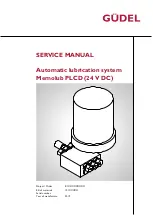
CPF 20/80 PARTICULATE AIR FILTER
Page 1
© 2007 CLEMCO INDUSTRIES CORP
•
www.clemcoindustries.com
•
Manual No. 04143
1.0 INTRODUCTION
1.1
Scope of Manual
1.1.1
These instructions cover setup, operation,
maintenance, replacement parts, and important warnings
to safely operate the Clemco CPF Particulate Air Filter.
1.1.2
These instructions also contain important
information required for safe operation of the filter. All
respirator users and maintenance personnel must be
trained to safely operate and maintain the filter and
respirators. The respirator users and all personnel
involved with the breathing air process must be able to
identify potential hazards associated with breathing
compressed air. Before using the filter, all personnel
involved with the operation must read this entire manual,
including the orange cover, plus the respirator manuals
and all accessory manuals.
1.2 Safety
Alerts
1.2.1
Clemco uses safety alert signal words, based on
ANSI Z535.4-1998, to alert the user of a potentially
hazardous situation that may be encountered while
operating this equipment. ANSI’s definitions of the signal
words are as follows:
This is the safety alert symbol. It is used
to alert the user of this equipment of
potential personal injury hazards.
Obey all safety messages that follow this
symbol to avoid possible injury or death.
CAUTION
Caution used without the safety alert symbol
indicates a potentially hazardous situation
which, if not avoided, may result in property
damage.
CAUTION
Caution indicates a potentially hazardous
situation which, if not avoided, may result in
minor or moderate injury.
WARNING
Warning indicates a potentially hazardous
situation which, if not avoided, could result in
death or serious injury.
DANGER
Danger indicates an imminently hazardous
situation which, if not avoided, will result in
death or serious injury.
1.3 OSHA
Compliance
1.3.1
When CPF Filters are used with a NIOSH-
approved supplied-air respirator, meets OSHA regulations
1910.94(a)(6)and 1910.134 (i)(5)(iii), requiring air for
abrasive blasting respirators shall be free of harmful
quantities of dust, mists, and noxious odors. CPF filters
provide a pressure-reducing valve to lower the pressure to
meet the pressure requirements of the respirator,
providing that the filter’s inlet pressure does not exceed
150 psi.
1.3.2
Important information concerning the quality of
compressed air, the use of respirators, and exposure to
hazardous dust is found in OSHA regulations 29 CFR
1910.94, 29 CFR 1910.134 and 29 CFR 1910.1000.
Note regulations 29 CFR 1910.94 and 29CFR1910.134
require that abrasive blasting respirators meet the
requirements for supplied-air quality. For total
compliance, the system must also include a NIOSH-
approved supplied-air respirator.
1.3.3
All supplied-air respirators using non-oil-
lubricated or oil-lubricated compressors shall have a
carbon monoxide monitor to meet the requirements of
CFR 1910.134 (i)(6) and (i)(7).
1.3.4
OSHA regulations 29 CFR1910 and
29CFR1926 require that respirator air line couplers be
incompatible with air lines for non-respirable use. This
prevents inadvertent servicing of respirators with non-
respirable gases or oxygen. It is the employer's or facility
owner's responsibility to comply with the regulation.
1.3.5
The CPF filter is to be used with NIOSH-
approved supplied-air respirators in atmospheres not
immediately dangerous to life or health (IDLH), with as
least 19.5% oxygen, and from which a user can escape
without the use of the respirator.
1.3.6
Breathing air used to supply the filter must be
respirable breathing air and contain no less than 19.5
volume-percent of oxygen. Breathing air shall also meet
the requirements for Grade D or higher quality, as
described in Compressed Gas Association Commodity
Specification pamphlet G-7.1., titled Commodity
Specification For Air, published by Compressed Gas
Association Inc., Chantilly, VA. CGA Website is
cganet.com






























